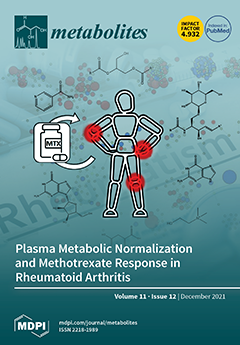As surrogate readouts reflecting mitochondrial dysfunction, elevated levels of plasma acylcarnitines have been associated with cardiometabolic disorders, such as obesity, gestational diabetes, and type 2 diabetes. This study aimed to examine prospective associations of acylcarnitine profiles across gestation with neonatal anthropometry, including birthweight,
[...] Read more.
As surrogate readouts reflecting mitochondrial dysfunction, elevated levels of plasma acylcarnitines have been associated with cardiometabolic disorders, such as obesity, gestational diabetes, and type 2 diabetes. This study aimed to examine prospective associations of acylcarnitine profiles across gestation with neonatal anthropometry, including birthweight, birthweight z score, body length, sum of skinfolds, and sum of body circumferences. We quantified 28 acylcarnitines using electrospray ionization tandem mass spectrometry in plasma collected at gestational weeks 10–14, 15–26, 23–31, and 33–39 among 321 pregnant women from the National Institute of Child Health and Human Development (NICHD) Fetal Growth Studies-Singletons. A latent-class trajectory approach was applied to identify trajectories of acylcarnitines across gestation. We examined the associations of individual acylcarnitines and distinct trajectory groups with neonatal anthropometry using weighted generalized linear models adjusting for maternal age, race/ethnicity, education, parity, gestational age at blood collection, and pre-pregnancy body mass index (BMI). We identified three distinct trajectory groups in C2, C3, and C4 and two trajectory groups in C5, C10, C5–DC, C8:1, C10:1, and C12, respectively. Women with nonlinear decreasing C12 levels across gestation (5.7%) had offspring with significantly lower birthweight (−475 g; 95% CI, −942, −6.79), birthweight z score (−0.39, −0.71, −0.06), and birth length (−1.38 cm, −2.49, −0.27) than those with persistently stable C12 levels (94.3%) (all nominal
p value < 0.05). Women with consistently higher levels of C10 (6.1%) had offspring with thicker sum of skinfolds (4.91 mm, 0.85, 8.98) than did women with lower levels (93.9%) during pregnancy, whereas women with lower C10:1 levels (12.6%) had offspring with thicker sum of skinfolds (3.23 mm, 0.19, 6.27) than did women with abruptly increasing levels (87.4%) (
p < 0.05). In conclusion, this study suggests that distinctive trajectories of C10, C10:1, and C12 acylcarnitine levels throughout pregnancy were significantly associated with neonatal anthropometry.
Full article






